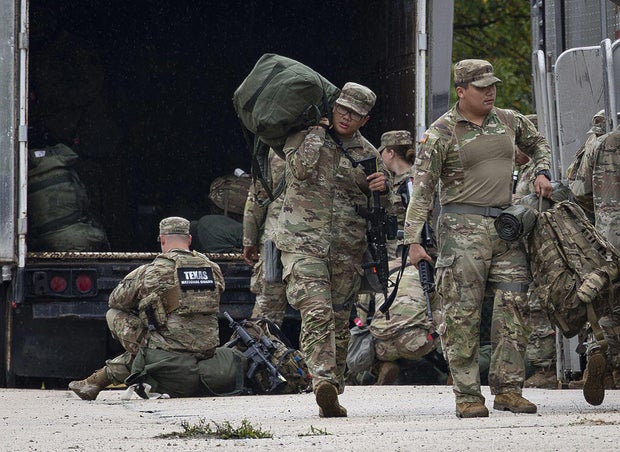Washington — President Trump’s administration asked the Supreme Court on Friday to allow the deployment of National Guard members in Illinois, teeing up a showdown over the president’s power to send troops into jurisdictions over the objections of local authorities.
The Justice Department is asking the high court to freeze a lower court order that blocked the Trump administration from ordering the federalization and deployment of National Guard troops within Illinois. A U.S. appeals court on Thursday upheld the decision as to the deployment of service members, but allowed the Guard to remain under federal service while legal proceedings continue.
In a request for emergency relief, Solicitor General D. John Sauer said the order from a U.S. district court judge “countermands the exercise of the President’s Commander-in-Chief authority and projects its own authority into the military chain of command.”
He argued that forbidding the deployment of federalized Guard troops “eviscerates” Mr. Trump’s decision to call into federal service 300 members of the Illinois National Guard to protect federal immigration officers and government property. The president also federalized up to 400 members of the Texas National Guard to assist in the Chicago area.
Brian Cassella/Chicago Tribune/Tribune News Service via Getty Images
“It deprives DHS officers of the protections that the President sought to give them from ongoing violence, prevents the Guard from ensuring the enforcement of federal law, and puts lives and property in danger,” Sauer wrote. “It also places the Seventh Circuit in the untenable position of controlling the military chain of command and judicially micromanaging the exercise of the President’s Commander-in-Chief powers, including the decision about which military forces the President can deploy.”
Mr. Trump has invoked a law known as Title 10 to federalize National Guard troops to protect immigration personnel and government facilities in several cities, where protests have sprung up in response to the administration’s immigration agenda. The law allows the president to call the members of any state’s National Guard into federal service if there is a “rebellion or danger of a rebellion” against the U.S. government, or if the president is “is unable with the regular forces to execute the laws of the United States.”
The Trump administration has argued that demonstrations in some cities, including outside of Chicago, satisfy those conditions, allowing the president to exercise his authority under Title 10. In Illinois, government officials have argued that “violence and the constant threat of violence” have left regular federal law enforcement forces in Chicago unable to fully execute U.S. immigration laws, as well as those against assaulting and obstructing federal officers.
The administration has also said that violence targeting federal authorities and property in Illinois in recent weeks constitutes a “rebellion or danger of rebellion.”
Mr. Trump had threatened for weeks to mobilize the National Guard within Illinois amid confrontations outside a processing facility for immigrant detainees in Broadview, a suburb of Chicago. Then, in early October, the president said the situation in Chicago had become dangerous for federal agencies, and exercised his authority to call members of the Illinois National Guard into federal service.
Illinois Gov. J.B. Pritzker denounced the move and called it “un-American to demand a governor send military troops within our own borders and against our will.”
The state of Illinois and the city of Chicago sued over the federalization of National Guard members, arguing that the directives are unlawful. The Trump administration has argued that courts cannot review the president’s move.
U.S. District Judge April Perry sided with the state earlier this month, finding that the Department of Homeland Security’s assessment of the events in Chicago to be “unreliable.”
A panel of judges on the U.S. Court of Appeals for the 7th Circuit then issued a preliminary order temporarily blocking the deployment of Guard troops in Illinois, but said they could remain under federal control. In its decision Thursday, a unanimous panel of judges maintained that posture, finding “the facts do not justify” Mr. Trump’s actions in Illinois.
“The spirited, sustained, and occasionally violent actions of demonstrators in protest of the federal government’s immigration policies and actions, without more, does not give rise to a danger of rebellion against the government’s authority,” the judges wrote in an unsigned ruling.
They also noted that federal facilities, including the processing center in Broadview, have remained open amid the protests against the Trump administration’s immigration policies, and said disruptions have been contained by local, state and federal authorities.
Clashes over the president’s immigration policies have led the president to federalize and deploy members of the National Guard to the Los Angeles area, Portland and Memphis. A federal appeals court allowed Mr. Trump to deploy roughly 4,000 of California’s National Guard to Los Angeles and is weighing a bid to allow the mobilization of troops to Portland.
Mr. Trump has also sent National Guard troops to the streets of Washington, D.C., and has threatened to deploy members to cities including Baltimore and San Francisco.




0 Comments